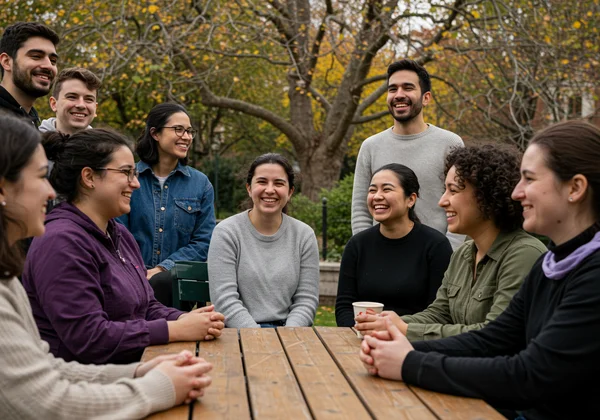Am I Asexual? An LGBTQ+ Orientation Quiz to Understand Ace & Aromantic Identities
Have you ever felt like you're on a different wavelength when your friends talk about crushes, celebrity heartthrobs, or their dating lives? It can be an isolating experience, leaving you wondering if something is wrong. The truth is, your feelings are valid, and you're not alone. For many, this feeling is the first step toward understanding asexuality and aromanticism. But is it normal to question my sexuality? Absolutely. Whether you're asking "Am I gay?", "Am I bisexual?", or "Am I asexual?", questioning is a brave and healthy part of getting to know your authentic self. This guide is here to help you explore these identities in a safe, supportive space. If you're looking for a tool to help you reflect, you can always start your journey with a broader exploration.

What is Asexuality? Exploring the Ace Spectrum
At its core, asexuality is a sexual orientation characterized by a lack of sexual attraction to others. It’s not about behavior; it’s about the internal experience of attraction. Understanding the asexual spectrum is key because, like all orientations, it's not a simple "yes or no" answer. It’s a diverse and nuanced landscape of human experience.
Defining Asexuality: Beyond Sexual Attraction
To understand asexuality, it's crucial to grasp what sexual attraction is: an innate pull or desire to be sexually intimate with a specific person. An asexual person (often called "ace") simply does not experience this pull. This doesn't mean they can't appreciate beauty, form deep emotional bonds, or even enjoy physical affection like cuddling. It just means the intrinsic drive for sexual activity with another person isn't there. It is a valid orientation, just like being gay, straight, or bisexual. Exploring these feelings is a crucial part of self-discovery, similar to how someone might take an am I gay test to better understand their attractions.
The Ace Spectrum: Gray-Asexuality, Demisexuality & More
The ace community uses a spectrum to describe the wide range of experiences. You might find your feelings resonate with one of these identities:
-
Asexual: Someone who experiences little to no sexual attraction.
-
Gray-Asexual (Gray-Ace): Someone who experiences sexual attraction very rarely, only under specific circumstances, or with very low intensity. It’s the "gray area" between asexuality and allosexuality (experiencing sexual attraction).
-
Demisexual: This term is part of the demisexual definition; it describes someone who only experiences sexual attraction after forming a strong emotional bond with a person. The emotional connection is a prerequisite for any feelings of sexual desire to develop.

Asexuality vs. Celibacy: Key Differences
A common point of confusion is the difference between asexuality and celibacy. Celibacy or abstinence is a conscious choice to refrain from sexual activity, often for religious or personal reasons. Asexuality, however, is an orientation—an innate part of who a person is. An asexual person lacks sexual attraction, while a celibate person may feel sexual attraction but chooses not to act on it.
Understanding Aromanticism: More Than Just 'No Romance'
Just as sexual orientation describes who you're sexually attracted to, romantic orientation describes who you're romantically attracted to. For many people, these two align, but they don't have to. Answering the question of what is aromantic helps separate these two fundamental concepts. It's a key piece of the identity puzzle.
Defining Aromanticism and its Spectrum (Aro-spec)
Aromanticism is a romantic orientation characterized by experiencing little to no romantic attraction to others. A romantic attraction involves the desire for a romantic relationship, often including emotional intimacy, "crushes," and the feelings typically associated with being "in love." People who identify as aromantic (or "aro") may not get crushes or desire a conventional romantic partnership. Like the ace spectrum, the aromantic spectrum (Aro-spec) includes a range of identities for those who experience romantic attraction rarely or under specific circumstances.
Asexual vs. Aromantic: Can You Be Both?
Yes, you absolutely can be both, one, or neither! The relationship between sexual and romantic attraction is unique for everyone. Here’s how they can combine:
- Asexual and Aromantic (Aroace): Experiences neither sexual nor romantic attraction.
- Asexual and Romantic: Experiences romantic attraction but not sexual attraction. For example, an asexual homoromantic person is romantically attracted to the same gender but isn't sexually attracted to anyone.
- Aromantic and Allosexual: Experiences sexual attraction but not romantic attraction. For example, an aromantic straight person is sexually attracted to the opposite gender but doesn't desire a romantic relationship.
Understanding this distinction can be incredibly validating. If you're curious about where your own feelings might fit, a confidential sexual orientation test can be a helpful starting point for reflection.

Signs You Might Be on the Ace or Aro Spectrum
There's no single checklist to determine if you're ace or aro, as everyone's journey is different. However, recognizing shared experiences can be a powerful tool for self-discovery. These are not diagnostic criteria, but rather points for gentle self-reflection.
Common Feelings and Experiences to Consider
Many people on the ace or aro spectrum report feeling out of sync with their peers growing up. You might relate to some of these common feelings:
- Feeling indifferent or even repulsed by conversations about sex or dating.
- Not understanding what people mean when they talk about having a "crush."
- Valuing deep friendships (platonic relationships) as the most important and fulfilling connections in your life.
- Feeling like you were "faking" or performing interest in dating to fit in.
- Never having looked at someone and thought, "I want to be in a relationship with them" or "I want to have sex with them."
Reflecting on Your Past: Dating & Relationships
Take a moment for reflecting on your own history. Did past relationships feel confusing or like you were following a script? Perhaps you enjoyed the companionship and emotional support but felt pressured by the expectations of romance or physical intimacy. Realizing you prefer platonic partnerships, or "queerplatonic relationships" (QPRs), which are deeply committed non-romantic partnerships, can be a major breakthrough for many aro and ace individuals.
Where to Find Support & Community as Ace/Aro
Discovering your identity can feel overwhelming, but you don't have to navigate it alone. Finding an ace and aro community is a vital next step. Online spaces like the Asexuality Visibility and Education Network (AVEN) are fantastic resources filled with information and forums where you can connect with people who share similar experiences. Finding your people reminds you that your identity is real, valid, and celebrated. If you want to continue this self-discovery process, you can always explore your feelings with our resources.

Your Path Forward: Embracing Your Identity
Understanding asexuality and aromanticism is about finding the language to describe your authentic experience. Whether you identify as ace, aro, somewhere on the spectrum, or are still figuring things out, your journey is uniquely yours. There is no right or wrong way to feel. The most important step is to be kind to yourself and allow yourself the space to explore without judgment.
Self-discovery is an ongoing process, not a final destination. If this article has resonated with you, it may be just one part of a larger exploration of your identity. To gain broader insights into your attractions and feelings, consider taking our free and confidential LGBTQ+ orientation quiz. Our comprehensive sexual orientation test is a supportive tool designed for self-reflection on your personal journey across the entire spectrum.
Frequently Asked Questions About Asexuality & Aromanticism
Is it normal to question my sexuality?
Yes, it is completely normal and healthy to question your sexuality and romantic orientation. Many people go through a period of exploration at some point in their lives. It's a sign of self-awareness and a courageous step toward understanding who you are.
Is asexuality a choice or a medical condition?
Neither. Asexuality is a sexual orientation, just like being gay or straight. It is not a choice, like celibacy, nor is it a medical condition or hormonal imbalance. It is a natural variation of human sexuality.
Can asexual people have romantic relationships?
Absolutely! Unless a person is also aromantic, they can and do have fulfilling romantic relationships. An asexual person may be homoromantic, biromantic, panromantic, or straight. These relationships are built on emotional connection, companionship, and intimacy, without the component of sexual attraction.
Is there an "Am I Asexual" test or quiz I can take?
While no online test can definitively label your orientation, a well-designed quiz can be an excellent tool for self-reflection. An ace spectrum quiz can help you explore your feelings about sexual and romantic attraction in a structured way. For a broader perspective, our LGBTQ+ Test helps users understand their feelings across the wider spectrum, offering insights that can clarify where you might fit.